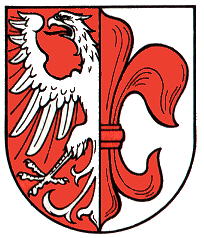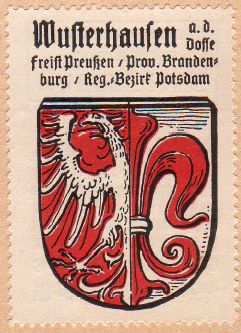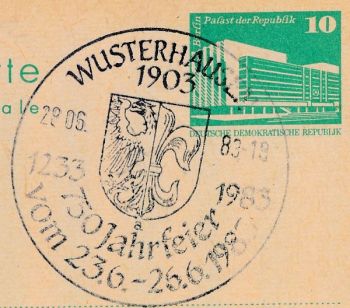Wusterhausen/Dosse: Difference between revisions
Knorrepoes (talk | contribs) m (Text replacement - "|'''English''' ↵| {{blazon wanted}}" to "|'''English''' | blazon wanted") |
Knorrepoes (talk | contribs) m (Text replacement - "{{de1}}" to "{{de}}") |
||
| Line 32: | Line 32: | ||
{{ | {{de}} | ||
{{media1}} | {{media1}} | ||
Revision as of 12:48, 25 July 2023
WUSTERHAUSEN/DOSSE
State : Brandenburg
District (Kreis) : Ostprignitz-Ruppin
Additions : 1997 Gartow; 1998 Bantikow (1973 Sechzehneichen), Blankenberg, Brunn, Ganzer, Kantow, Lögow, Schönberg (1957 Tramnitz, Wulkow), Segeletz; 1999 Trieplatz; 2001 Barsikow, Bückwitz (1974 Metzelthin), Dessow, Nackel (1954 Läsikow)
| German | Gespalten von Rot und Silber; vorn ein halber silberner Adler am Spalt und hinten eine halbe rote Lilie. |
| English | blazon wanted |
Origin/meaning
The arms were officially granted on December 2, 2005, but have been use for a much longer time.
The arms are a combination of the arms of the eagle of the Von Plotho family, and the fleur-de-lis of the Counts of Ruppin. The village developed around the castle of the Lords of Plotho in the 13th century. In the 14th century the city became a possession of the Counts of Ruppin. The combination already appeared on the 14th century seal of the city.
| The arms as shown at the end of the 19th century |
The arms by Hupp in the Kaffee Hag albums +/- 1925 |
| Postal cancellation 1983 |
This page is part of the German heraldry portal Deutsche Wappensammlung |
Heraldry of the World |
|
German heraldry:
|
Selected collector's items from Germany:
|
Literature: Bensing et al., 1984; Hupp 1896, 1898





